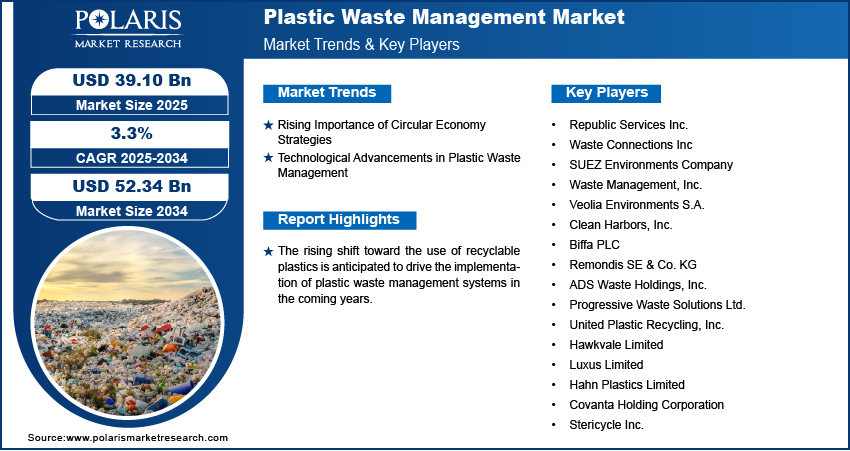Plastic Waste Management Market Size Worth USD 52.34 Billion by 2034 | CAGR: 3.3%

The global Plastic Waste Management market size was valued at USD 37.90 billion in 2024. The market is projected to grow from USD 39.10 billion in 2025 to USD 52.34 billion by 2034. It is projected to exhibit a CAGR of 3.3% from 2025 to 2034. Improved economic conditions, demographic and socio-economic changes, and environmental concerns are among the key factors influencing the plastic waste management market growth.
Market Overview
The plastic waste management market is gaining rapid momentum as environmental concerns, regulatory frameworks, and sustainability efforts push industries and governments toward effective waste handling and recycling solutions. Growing awareness around the environmental hazards of plastic pollution has led to the implementation of stricter regulations and greater investments in waste management infrastructure globally.
This market encompasses collection, segregation, recycling, and disposal methods designed to reduce plastic waste and minimize environmental impact. The focus is shifting from traditional disposal techniques to innovative, circular economy practices that promote reusability and sustainable product design across industries including packaging, automotive, construction, and consumer goods.
Request For Sample:
Market Size & Forecast
- Market Size (2025): USD 39.10 Billion
- Revenue Forecast (2034): USD 52.34 Billion
- CAGR (2025–2034): 3.3%
Trends & Insights
- Shift Toward Circular Economy: Companies are increasingly adopting circular models that focus on reuse, repair, and recycling of plastics to reduce dependency on virgin materials.
- Technological Advancements in Recycling: Innovations like chemical recycling, AI-based sorting, and bioplastics are revolutionizing how plastic waste is treated and reprocessed.
- Rise in Extended Producer Responsibility (EPR): Governments are enforcing EPR policies that hold producers accountable for post-consumer plastic waste, fostering sustainable design and collection systems.
- Public-Private Collaborations: Strategic partnerships between municipal bodies and private companies are expanding infrastructure for plastic waste collection and processing, particularly in emerging economies.
Key Growth Drivers
- Increasing plastic consumption in packaging and consumer products
- Strict government regulations and international policies on plastic disposal
- Rising consumer awareness and demand for eco-friendly products
- Growth in recycling technologies and sustainable packaging solutions
- Urbanization and industrial development driving waste generation
- Incentives for recycled plastic usage in manufacturing sectors
Conclusion
Driven by sustainability and innovation, the plastic waste management market is transforming global waste strategies while offering massive growth opportunities across recycling, reuse, and circular economy frameworks.






